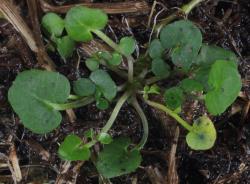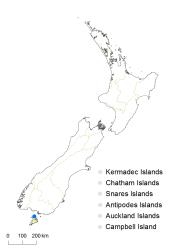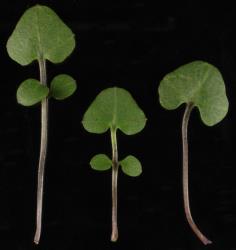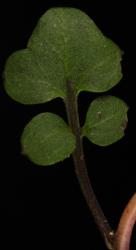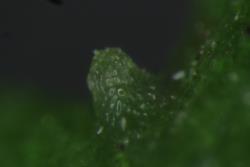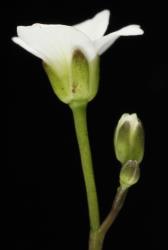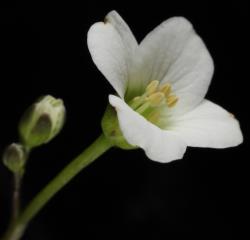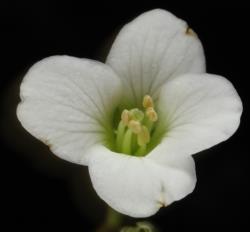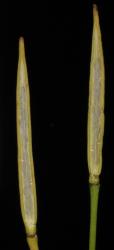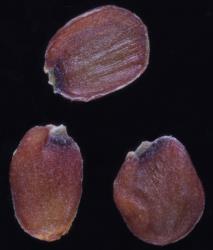Perennial herb, single rosette or with short, lateral branches. Leaves up to 65 mm long, pinnatisect; lamina 9.0–27.0 × 6.0–16.0 mm, green to dark green, membranous, glabrous; hydathode in leaflet axil, up to 0.2 mm long; petiole up to 65 mm long. Terminal pinna 8.0–15.0 × 11.0–15.0 mm, simple, pandurate, broadly pandurate to rhomboid-pandurate; margin entire, with 2–4 distinct hydathodes; apex obtuse with a distinct hydathode; base cordate to truncate. Lateral pinnae 1–2, 1.5–6.0 × 1.1–6.2, orbicular, broadly orbicular to broadly elliptic-orbicular, weakly pandurate; apex obtuse; base attenuate to obtuse; petiolule 0.2–1.5 mm long. Cauline leaves similar to rosette leaves but usually smaller; terminal pinna up to 7.0 × 7.6 mm, lateral pinnae up to 3.7 × 2.4 mm. Inflorescence racemose, sometimes with lateral racemes, each raceme 3–5-flowered; peduncle up to 190 mm long, 0.5–1.2 mm diam. At base, ascending, glabrous. Pedicels 14.0–32.0 mm long, 0.5–0.8 mm diam., glabrous. Sepals 2.7–3.1 × 1.2–1.5 mm, elliptic-oblong, saccate, green to red-brown, glabrous, margin white and membranous, apex obtuse, base truncate. Petals 6.0–7.0 × 4.2–4.5 mm, white, limb broadly obovate; apex obtuse; base cuneate, tapering to a 1.0–1.5 mm long claw. Stamens 6; median filaments 4, 3.2–3.4 mm long; lateral filaments 2, 2.2–2.3 mm long; anthers 0.7–0.8 mm long, cream to pale yellow, when dehiscent held at a similar height to or slightly below the stigma. Ovary 3.8–4.0 mm long, c. 0.8 mm diam., ± terete, green, glabrous; ovules 14–18; style c. 1.0 mm long, ± terete; stigma 0.5–0.6 mm diam. Siliques 23.0–28.0 × 2.1–2.4 mm, glabrous, style 2.8–3.0 mm long; valves green to yellow-green at maturity and when dehiscent; replum 0.4–0.7 mm wide. Seeds 1.4–1.8 mm long, 1.0–1.2 mm wide, 0.2–0.3 mm thick, oblong, broadly oblong to orbicular-oblong, henna-green to henna; wing absent.
Cardamine megalantha is distinguished from C. reptans by its coriaceous leaves with prominent marginal hydathodes, larger terminal leaflet and fewer lateral leaflets, leaflets with distinct petiolules and axillary hydathodes, and elongated inflorescences.
Stewart Island.
Cardamine megalantha is known only from the summit of Mt Anglem, Stewart Island.
Cardamine megalantha occurs in sheltered sites among rocks and underneath shrubs.
Cardamine megalantha is assessed as having a conservation status of Threatened—Nationally Endangered A(3), with the qualifiers One Location and Data Poor (de Lange et al. 2018). The qualifier Data Poor is applied because information is required on the number and size of the populations.
Flowering January; Fruiting February.



